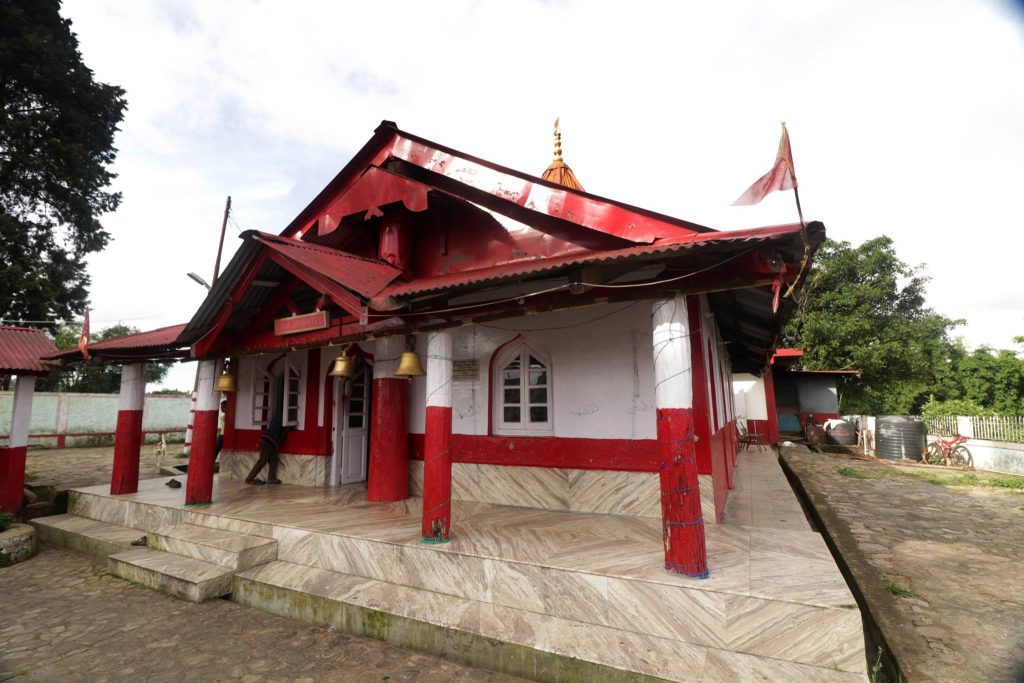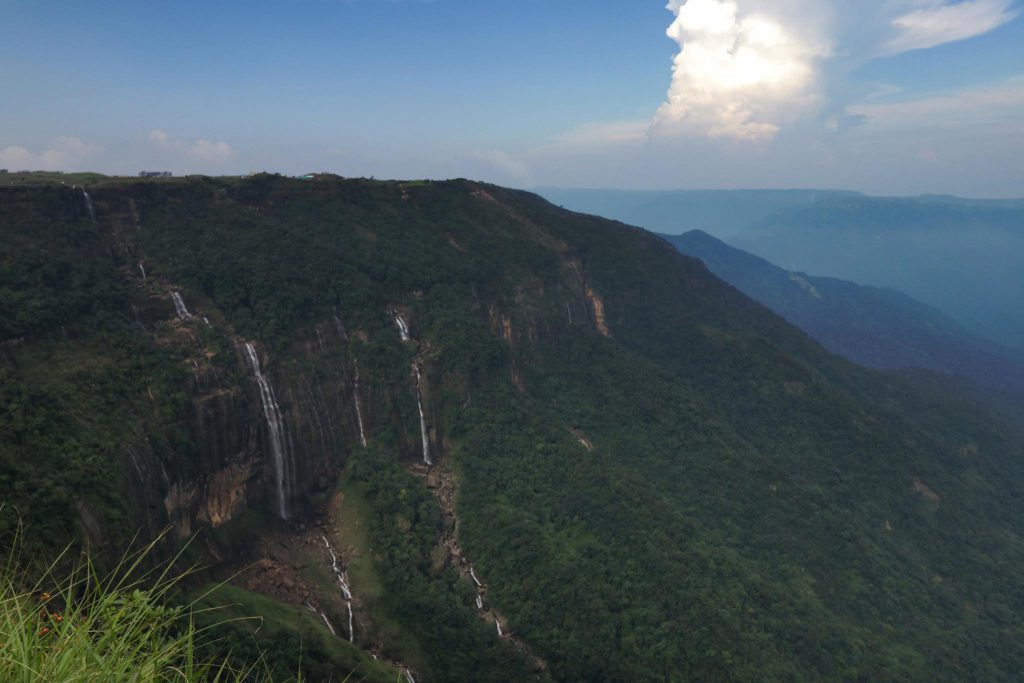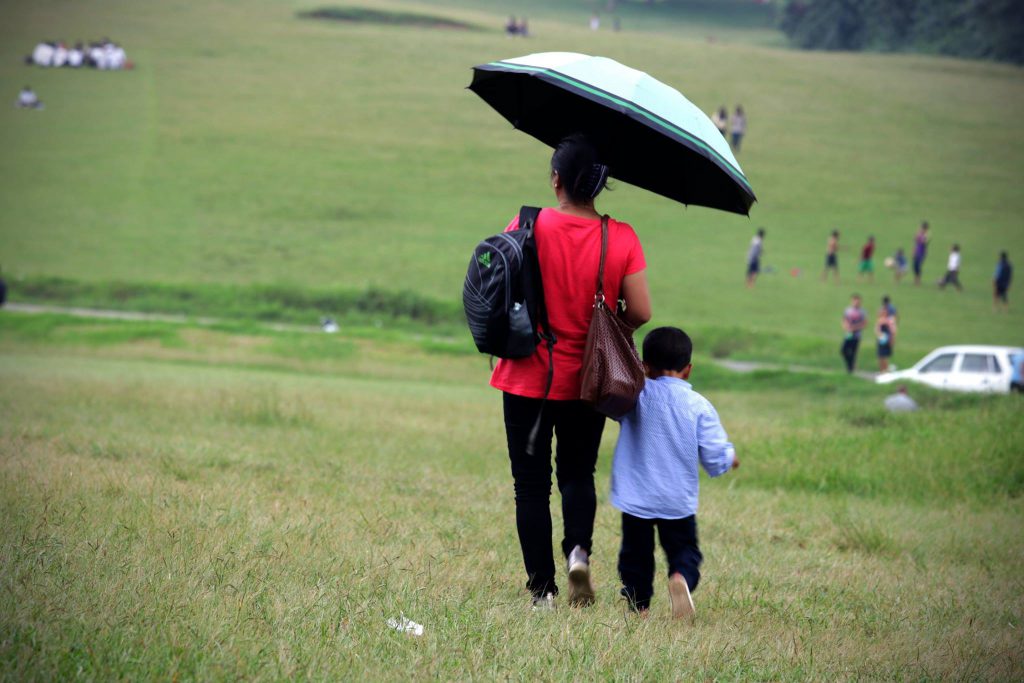Meghalaya, which in Sanskrit means “the abode of clouds” is a state in North-East India. It is bounded on the North and East by Assam and on the South and West by Bangladesh. Meghalaya consists of 3 hills, the Khasi Hills, the Jaintia Hills and the Garo hills.
We decided to catch Meghalaya in its monsoon beauty and planned a trip in the second week of August (11th – 15th August). The maximum rainfall occurs in the southern slopes of the Khasi hills. Sohra (Cherapunjee) and Mawsynram is said to receive the highest rainfall of the world.
Day 1: Kolkata to Shillong and around Shillong:
We, a group of 6 people took the 6.50AM flight on 11th August from Kolkata airport and landed in Guwahati around 8.10 AM. Right before landing in the Guwahati airport all I could see from the flight window is greenery.


The arrival:
The weather was pleasant, a bit cloudy and a nice cool breeze was blowing. Prior to our visit we had already booked a car ( Chevrolet Enjoy) for our entire trip and an entire apartment through Airbnb in Mawblei, Shillong. Our driver was waiting for us in the parking lot and without any delay we teed off.
We took NH-40 from Guwahati to Shillong. The road is smooth and well maintained, the scenic beauty was amazing and the weather just added more pleasure to the trip. We halted at a roadside restaurant for a quick breakfast and again hit the road.
Umium Lake:
Some 15 kms before entering the main city of Shillong lies the Umiam Lake (commonly known as Barapani Lake).

It is a reservoir in the hills created by damming river Umiam. We spend some time taking photographs and catching the beauty of the lake. Moving on as we were entering the main city, we got struck in a big traffic jam, which our driver (Bimal da) informed us is a daily affair. The huge jam was making us all impatient and as we were just starting to wonder what’s so different here from other cities, Bimal da stopped at the Meghalaya Golf course.
Meghalaya Golf course:
My, O My!! A place so lush green and all I could see is stretches of well maintained green fields all around me. I never thought a golf course could give me such a feeling of infiniteness. Local kids were playing football while we sat on the grass and enjoyed the view. Few Khasi women were selling pineapples, which is one of Shillong’s principle agricultural product. All of a sudden out of nowhere it started raining. The light drizzle forced us back in the car. We bought a pineapple and started moving towards Ward’s Lake, our next stoppage.


Ward’s Lake:
Ward’s Lake also known as Pollock’s Lake, is an artificial water body encircled by an extensive lush garden and lies in the middle of the city. The horse-shoe shaped lake is encircled by colorful floral bed and there is cobbled stone path for walking around the lake. There is a wooden bridge over the lake from where one can feed the fishes.






Cathedral Catholic Church:
Our final stop before reaching the apartment was at Cathedral Catholic Church, which is located between Dhankheti and Laitumkhrah. This church is erected on the same site where the first church of Shillong was built, after the first church was destroyed by fire. The church was constructed atop an emerald-colored hill with stunning stained glass installations and tall arches and has been made earthquake resistant by filling the rock trenches with sand, thus making the foundation, strong. The grave of the First Archbishop of the city, Hubert D’Rosario, is located near the church’s altar.




The Stay:
We reached our apartment around 3.30PM. The caretaker, Bankit had prepared a nice lunch. After lunch and some rest, we decided to visit the heart of Shillong, Police Bazar. There are plenty of staying options at Police Bazar within a wide price range. The market was thronging with people and we took a stroll, had some snacks and returned back. Our apartment was located near Shillong peak and at night it gave a mesmerizing view of the city down below. We had a quick dinner and called it a day.



Day 2: Dawki and Mawlynnong
We started around 8:00AM next morning, for Dawki and Mawlynnong, the cleanest village of Asia.
Dawki:
Dawki is about a 95km drive from Shillong through some deep gorges and canyons. Dawki is the border between India and Bangladesh. The Umngot river flows though Dawki and separates the Khasi hills from the Jaintia Hills. A single span suspension bridge was constructed over the river to connect the two hills. As it was monsoon, the river was not in its usual turquoise blue color but still the water was clear enough to see the river bed and small fishes.
We hired two boats, 3 person per boat, and took a tour in the river. It was an amazing feeling. The monsoon has given birth to several waterfalls in both the hills and their water was adding to the river. Our boatsman took the boat to the side of the hills and we got splattered by the water from the falls. Several localite were fishing in the river as we landed on a small island. We took a stroll, put our feet in the cold water of Umngot and captured the moments.






We were hungry and decided to have lunch in the village of Mawlynnong. On the way to Mawlynnong we came across Dawki Falls and Borhill Falls. These are the lesser known falls of Meghalaya but their beauty and aggression is no less. The mist from the falls completely drenched us as we approached the falls.


Mawlynnong:
In Mawlynnong, almost every house serves lunch to tourists. As it was a Sunday, the lunch service were all closed, so we had our lunch in a home-stay outside the village some 500 meters away from a single living root bridge. The food was simple but good. The interesting part was the locally made pickle. It was too hot for us but still then we couldn’t resist ourselves from having it. A good thing I learnt from Mawlynnong village is the importance of self-time or family-time. Sunday is obviously the most preferred day for tourists yet they keep the restaurants close so that they can have a day for themselves and their family.
After lunch we decided to trek the single living root bridge first. It was a easy trek, then we decided to go up the hills to see the bamboo hut and do the sky-walk trek. We entered the Riwai village, which is somewhat similar to Mawlynnong. At the end of Riwai is the sky-walk trek, which is basically a bamboo bridge extension from a tree overlooking Bangladesh. I won’t say its a must try thing but one can definitely give it a try.



We revived our energy lost from the trek, on our way to Mawlynnong. The cleanest village in Asia lives upto its title. It is a calm quiet village nestled in the Khasi hills. The place feels different all together.
As the next two days had lot of activities planned, we decided to return home early but nature had other plans for us. Meghalaya lived up to her name and on our way home as it was getting dark, we were engulfed in cloud. We had zero visibility but Bimal da being an expert driver got us through that with his safe pair of hands. About half an hour later the clouds moved away only to engulfed in the clouds again some time later. The ride back to our apartments was very thrilling but equally dangerous.
Bankit had made Jadoh rice for us for dinner. Not that all of us really liked it but it was not that bad either.
Day 3: Krangsuri Falls
The main attraction of this day was the Krangsuri falls and we planned our day around that. Krangsuri falls lies in the West Jaintia Hills district, and was the best falls in our entire trip. It is a hidden gem, still not popular among tourists.
A 95km drive took us to the base of the falls. On the way to the falls we came across Stone bridge. The bridge consists of huge granite stone slabs perched on equidistant similar looking pillars. We were pretty amused by the architectural technique. Bimal da informed us that the Stone bridge was used as a trade route with Bangladesh. Also on the other side of the road almost opposite to the bridge is Muwi Waterfalls.
On reaching the parking of the falls, we ordered lunch in a local shop and started our trek towards the falls. One has to walk down some 500 steps to reach there but believe me it’s worth the effort. We had already decided about taking a bath in the falls and were dressed accordingly.
Few steps down the track there is view point which gives a top view of the falls and the small reservoir beyond it to hold the water. The view was breath-taking. We couldn’t wait to take a plunge in the turquoise water of the falls. Suddenly it started raining. Hence without wasting any time, we rented life jackets and quickly wore them. After that kept our belongings under our umbrellas to protect from rain and were ready for the swim.


Wearing life jacket is mandatory as the water is deep and there is downstream current. There is even a guy appointed for checking if we wore the jackets properly before taking the plunge. The water was cold and even the tallest guy in our group was facing some difficulty in getting a foothold on the stones under the water. We were a bit scared but somehow gathered enough courage to take a leap of faith. Much to our relief the life jackets kept us afloat. It was raining heavily and we were splashing around like ducks.

Our target was to swim beyond the curtain of waterfall and stand behind that. Since it’s monsoon, most of the rocks were immersed in the water. Finally we huffed and puffed our way beyond the water curtain and managed to climb on the rocks behind the falls. We felt victorious. The view was amazing through the water curtain.
The rain also stopped in the meantime. After spending some more time floating around, we got up. There is clean changing rooms and washroom for both men and women.
After a change of clothes, we took the cobbled road to reach the reservoir made on top of the falls. The swim made us really hungry and after a few clicks we started climbing back to the parking where lunch was waiting for us.





Tyrshi falls:
Tyrshi falls was right there in our bucket list but Bimal da said going there is a bit risky. Due to monsoon, the 5km road we have to trek will be a bit dangerous. We have heard Tyrshi falls is Jowai’s answer to Shillong’s Elephant falls but unfortunately couldn’t see it.

Nartiang:
Our next stop was the village of Nartiang which is significant for its Summer Palace of the Jaintia King whose Capital was Jaintiapur. The village boasts of Nartiang Monoliths and Durga Temple.
Monoliths exists almost everywhere in the Khasi and Jaintia hills. However, Nartiang Monoliths has the biggest collection of monoliths stones in one single area. These consists of Menhirs (Vertical stones) and Dolmens (flat stones in the horizontal position). The tallest Menhir in this area was erected by U Mar Phalyngki, a trusted lieutenant of the Jaintia King to commemorate his victory in battle. Other monoliths were erected by U Mar Phalyngki, U Luh Lyngskor Lamare and various clans of Nartiang village between 1500A.D. and l835A.D.


Durga Temple:

The Durga Temple here is one of the 51 piths in India. Situated adjacent to the ruins of the Summer Palace of the Jaintia King, it is believed to be constructed by the Jaintia King on his conversion to Hinduism. During the rule of the Jaintia Kings, human sacrifices were offered to Goddess Durga. Within the temple there is a tunnel that reaches the river Myntang and it is through this hole that the heads were rolled down to the Myntang River. Human sacrifice was banned during British rule and goats are now sacrificed. It is also due to this human sacrifices or ‘narabali’, Nartiang got its name.
We were pretty tired after the swim in Krangsuri falls, so decided to skip Smit and retired to the apartment after having tea and snacks at a local shop.
Day 4: Shora
Double Decker Root Bridge:
The big day. The day for the Double Decker Living Root Bridge trek!! We started off pretty early at 6.30 AM, as it was going to be a long day. At Mawkdok Dympep Valley view point we halted for a quick breakfast. The view from the view point is breathtaking. In front of you is an infinite green valley. Somewhere it gave me a sense of freedom, a feeling that is unexplainable.


The drive towards Sohra was serene. We next stopped at Wah-kaba Falls. For me that was the most scenic falls of the whole trip, with the blue sky above with white clouds floating around and the water falling from a green mountain.

We wished to spend some more time there but the trek was on our mind. Therefore we hurried back to the car. One of the highlights of out trip was the trek to the Double Decker Living Root Bridge in Nongriat Village in Sohra (Cherapunjee). The drive from Sohra market to Tyrna starts across lush grasslands on one side and then rapidly descends across 20,000 feet to Tyrna on a narrow mountain road.


The hike:
The hike begins from Tyrna. We rented walking stick and started the descend. In total there are 3700 steps, which begins with an endless descend of almost 2000 steps which then comes to a halt at a diversion with a patch of stoned pathway. Then another stretch of steps followed by walking through the pathway, leads to a suspension bridge. Below this bridge is a natural swimming pool overflowing with turquoise water. The bridge is made of rusty iron cables repaired and supported at some parts with bamboo and some parts held together with steel wires. The whole bridge shakes and swings as we try to cross it, and the water flowing below make the whole experience fabulous.



Since it was monsoon, getting down there was restricted. After crossing this bridge starts an upward hike through another stretch of stairs. Following that we crossed another recently constructed cable bridge, then a single living root bridge which is approximately 400 years old. A final climb up through another stretch of stirs and Voila!! Before us lies the Double Decker Living Root Bridge with her waterfall in all grandeur. This natural bridge is said to be over 300 years old and just gets stronger over time – unlike man made bridges.


The most refreshing part was climbing into the pool of cold water of the falls after the tiring hike. As you sit in the pool, small fishes come and eat away the dead cells from the leg. I got a natural fish spa here at totally free of cost.




The bad part here is there is only a single changing room for everyone. After spending over an hour in the water, we started our climb back. The toughest part of the trek was the last 50%, where we climbed up that 2000 steps with which the hike started. Finally, we huffed and puffed our way up and were able to complete the total trek in 5 hours.
Seven Sisters Falls:
Next, it was time for the famous Seven Sisters Falls. Though it is said to be seven sisters we could only count five. Even in full monsoon, only five falls could be counted. It is heart-breaking to conclude that most probably two falls have almost dried off.


Nohkalikai Falls:
Our penultimate stop of the day was at the famous Nohkalikai Falls. This falls has an aura of its own, cascading down from the top of the gorge with a rumbling sound to the mystic turquoise pool below.


Elephant Falls:
Last but not the least, we stopped at the Elephant falls, which is a three storied falls before heading back to the apartment and thus marking our trip to an end.

Day 5: Adieu Meghalaya


Though we didn’t want to leave so soon, but our vacation was over and with a heavy heart we bid adieu to Meghalaya. I have been to many hill stations from different parts of India, but Meghalaya have carved in a special place in my heart. We were lucky the weather favored us through out our trip and the greenery and the waterfalls in their full grandeur added to the charm.





11,212 thoughts to “Mesmerizing Meghalaya”